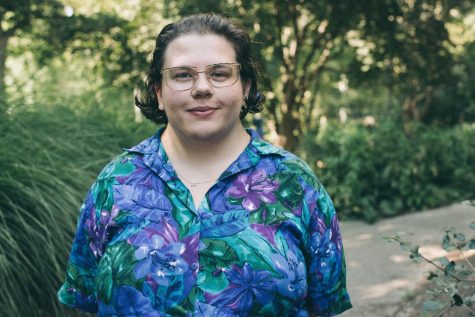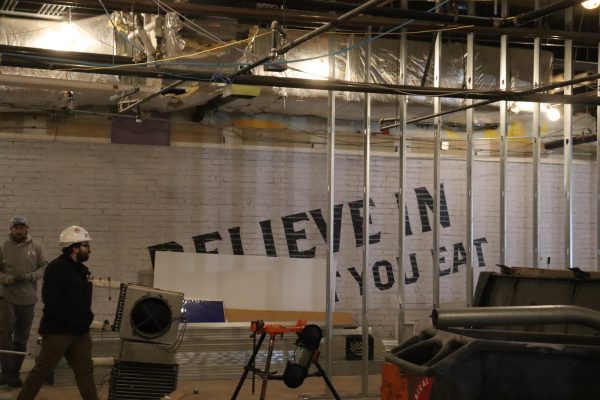The 17% – Trying to Create Meaningful Inclusion
In 2007, you could count the number of faculty of color in the School of Communication on one hand. Three black faculty members and two Asian American members.
When Angie Chuang, now an associate professor, accepted a role as an assistant professor in the journalism department, she singlehandedly doubled the full-time Asian American faculty of SOC. She became one of two people of color on the full-time faculty of the journalism department, others had retired or moved on from American University.
“It was sort of a celebration to have any diversity at all,” Chuang said.
For school administrators and faculty of color alike, any increase in the number of people of color was a success.
“That was the perception that we were just trying to get our numbers up,” Chuang said. “And I still remember the discussion of students: ‘Can we count international students as students of color? If we count the Asian American student population or the Latin American student population, can we count them?’ The question was less about how can we ensure that these new populations were treated equitably, and they were a true part of the community”
That year, according to the 2007-2008 Academic Data Reference Book, an annual report published by the Office of Institutional Research & Assessment, there were 97 faculty of color, not including international faculty, out of 559 total teaching faculty — just 17 percent.
Almost a decade later, the percentage is unchanged. While 49 people of color were hired into full-time faculty positions between 2007 and 2015, they still account for 17 percent of the faculty population.
This stagnation in growth affects faculty of color in many ways. Faculty of color not only deal with microaggressions, actions or statements of indirect, subtle or unintentional discrimination, from peers and students. They are tasked with the burden of invisible work and additional service burdens. Their behind-the-scenes work often goes uncompensated.
This usually takes the form of mentoring students, being called upon to perform additional service, serving on committees, speaking on panels and evaluating curricula.
While the administration tries to hire more faculty of color and engage in meaningful inclusion, how successful they may be is ultimately framed and largely determined by faculty compensation, retention and the culture of academia.
*****
As a newly minted tenured professor, Theresa Runstedtler, associate professor in the Department of History, says she barely had a chance to breathe before she was asked by administrators to run the Critical Race, Gender and Cultural Studies Collaborative.
Launched in the spring of 2016, the collaborative unites AU’s interdisciplinary studies programs that tend to serve under-represented students on campus: African American and African Diaspora Studies, Arab World Studies and Asian Studies among others.
The collaborative was built because each program was housed in separate departments and lacked dedicated administrative resources. According to Runstedtler, the collective aims to bring more resources to the programs so more full-time and tenured faculty members are teaching classes allowing for “enough support to actually be a really coherent robust program.”
Runstedtler considers her role as an example of the invisible work she participates in on campus.
“There’s not that many people who are tenured on this campus who are available to chair that type of unit,” Runstedtler said. “You kind of feel like, ‘Okay if this is something that I really want to see come into existence because this would make my life better at the institution and I think this would make students lives better at the institution.’ You’re caught in this Catch-22.”
This Catch-22 is trying to find the balance between working on papers, books and research –– the cornerstones of academia and the steps needed to raise your profile and earn promotions –– with creating an inclusive community within your department that not only attracts more faculty of color but creates safe spaces for them.
“That’s not to say it’s not important work,” Runstedtler said. “It’s just not really recognized. You can certainly get a lot of personal satisfaction out of doing it, but what ends up happening is that people who don’t have to do those kinds of services, they have a lot more time to just unplug and do their own research to publish and publish and publish.”
In 2011, a study published by The American Association of University Professors (AAUP) found that faculty works an average of 64 hours per week. Within this, there is a gender gap: Women work slightly more than men on average but spend less time on research and more time on teaching and service. Men, on average, spend an additional 7.5 hours of research per week as compared to their female colleagues.
The untenured female faculty is then unable to publish at the same rate as their male peers, affecting their chance at tenure.
Elizabeth Suhay, an assistant professor in the Department of Government, says that working with and mentoring students is a central component of her work. She estimates that she had close to 100 individual meetings with students in the fall semester, both after class and in office hours, typically ranging from 15 to 30 minutes each.
“We are not a huge state university, where you’re doing big lectures of 200-300 people,” Suhay said. “It’s a smaller, more teaching-oriented place. Students are paying a lot of money in part because they expect to get some degree of one-on-one time with their professors.”
In the wake of the election results in early November, Suhay says she saw a marked increase in the amount of time she was meeting with students. She says that she had a “steady stream” of students — predominantly women, and students of color — who wanted to meet with her after the election results.
“The negativity, and the prejudice, and sexism surrounding this election has been hard on students,” Suhay said. “Some students just really needed somebody to talk to and [to] process their feelings, and in some cases, have their worries calmed a little bit.”
Working with students is difficult to quantify and reward accordingly in comparison to teaching, publishing and formal service on committees. Untenured faculty are often counseled to not overburden themselves with service, avoiding formal service like being on many committees. But choosing to steer away from all committee service may affect tenure chances, even if it is the norm. Once faculty receives tenure, they often begin committing themselves to more formal service.
“Particularly with students of color or minorities, people that need safe space or somebody to talk to, some faculty takes that burden more than others,” said Ernesto Castañeda, assistant professor in the Department of Sociology. “Not always, but it tends to be people, particularly women, of color who take that informal mentoring role that doesn’t get quantified, doesn’t get rewarded by the department and a lot of times the administration isn’t even aware of it in the sense of how many hours we put into it.”
Mary Clark, the dean of academic affairs, says that if the university values faculty mentoring for students, it should be on the student assessment form (which is currently being considered) like it is on the faculty assessment form. It should further be considered in the annual review and compensation could be informed by whether someone is mentoring effectively or not.
The types of service performed are also gendered. Studies have shown that women’s service to their male peers is asymmetrical where they are asked to do less-prestigious service, such as being the director of undergraduate students over department chair or program director.
Outside of formal service, when sourcing faculty members to speak on panels, faculty of color and female faculty may be called upon to diversify panels. As there are more white males working at the university, certain individuals can be called upon disproportionately to their peers.
Clark realizes that these service burdens and invisible work are an obstacle to the retention and prosperity of faculty of color. She is working to make sure there are safeguards in place to aid those faculty members for whom the weight is too heavy.
“[We have to] make sure that we are providing meaningful, positive opportunities for our faculty of color and that they’re receiving the mentorship that they need and that they’re not being unduly burdened with service,” Clark said. “It can be a real burden and disabling force to have greater service obligations and expectations.”
*****
When Chuang started in 2007, diversity and inclusion meant getting numbers up –– figuring out a way to make those numbers look diverse. These numbers were solely based on self-identified race, ethnicity and sex, consistent with the federal government’s emphasis.
“There was no discussion about inclusion, which is different than increasing our numbers,” Chuang says. “We have to create an environment that reflects the most supportive environment for the demographic of the population.”
But it is impossible to have a healthy and diverse community without more meaningful inclusion.
This is in part made possible by formal recognition. Clark defines meaningful inclusion as when: “work produced by faculty of color is valued and celebrated and recognized with faculty awards. It means that having appointed a more diverse faculty we’re then mentoring all faculty, making sure that we’re mentoring faculty of color and that they’re being retained by the university.”
Chuang immediately felt this shift to thinking about diversity in tandem with meaningful inclusion.
It was seen in receptions and events AU put on for faculty and students of color. There were events for networking within every minority group. These events started out as awkward. A handful of faculty members who all knew each other huddled around a table chit chatting. But they grew.
Soon, events were taking up large conference spaces in the Mary Graydon Center. There were several events where dozens of faculty members and students networked. New faces Chuang had never encountered before.
“The fact that there was this event is a good example of meaningful inclusion, that there’s an attempt to say you know what we want you to be part of a larger community and we understand that you want to be able to network and find common ground with people who share this social identity,” Chuang said.
Creating inclusive spaces is largely tied to trying to retain the faculty of color already in the school so there are safe spaces that allow organic mentorship and networking.
The Diversity and Inclusion Working Group within the Faculty Senate and the RISE initiative are two programs at AU that focus on meaningful inclusion and faculty relationships with students, respectively. The RISE initiative looks at how the faculty can better the student experience at AU.
Derrick Jefferson, an assistant librarian, is the chair of the Diversity and Inclusion Working Group. He points to the importance of meaningful inclusion on campus.
“We’ve all been at that party, at that dinner party, that event, when everyone seems to know everybody and we’re that one outsider who’s not that familiar with people and it’s frankly, an awful feeling and place to be,” Jefferson said. “So how do we subvert that feeling for people?”
This experience can lead to feelings of tokenization, which Clark says can be addressed in part by more inclusive hires.
AU is currently conducting 35 faculty searches. When overseeing the searches and appointments, Clark makes clear to the different schools and colleges that their goal is to appoint “diverse, excellent faculty.”
By increasing the numbers and making sure that diverse and excellent faculty is not concentrated, Clark says this will help alleviate the feeling of feeling tokenized or marginalized within their department or the school.
“I think that our units are trying to do a better job and are being encouraged by the administration and hopefully with the new presidency, we will have even more initiatives and incentives to improve diversity and retain faculty at AU,” said Larry Engel, an associate professor in the School of Communication and member and former chair of the Diversity and Inclusion Working Group.
However, hiring a more diverse faculty is unsustainable if they do not stay. Campus climate, mentoring opportunities, and pay affect whether faculty stays at AU.
“It’s not completely a matter of recruiting of faculty,” Jefferson says. “I think there’s no shortage of good people that are qualified and capable of being on the teaching faculty or other variations of the faculty on campus. It’s got to go deeper than that. Why aren’t people staying? What is the climate like here? What makes people feel that maybe this isn’t the place for me?”
AAUP data suggests that compensation is one of the most important variables for retention rates of assistant and associate professors.
“What we did not recognize quickly enough was that creating a diverse, a more diverse, student body and trying to do the same with faculty, is harder than you think,” Engel says. “It’s very hard with faculty mainly because people of color are really in demand and our university doesn’t pay top dollar and it’s honestly hard to compete.”
To establish competitive salaries, the administration uses data provided by the College and Universities Professional Associations to benchmark salaries against other college-centered research universities.
Peer institutions include Georgetown University, Tufts University and Tulane University. If a faculty member has received a competitive offer from another university, they will try to retain the member by meeting the offer.
Information on AU’s average salaries is published in Academic Data Reference Book. The average salary of an untenured assistant professor is $82,224. Once they receive tenure, average salary increases to $103,842. Full professors have an average salary of $160,124.
Salaries also vary by school, with the School of Communication and College of Arts and Sciences having the lowest salaries and the Kogod School of Business and the Washington College of Law with the highest.
*****
In 1989, AU was a party school. Students would hang out on the quad with t-shirts listing their first choices above AU. The number of students of color was so small that almost everyone knew each other.
For Caleen Sinnette Jennings, professor of theater and chair of the President’s Council on Diversity and Inclusion, reflecting on her first fall in 1989, AU has grown into a radically different school. There was a shift in the caliber of students and faculty. It has become a place where students seek out activist culture and have unique experiences different from high school.
“I’ve seen a growing understanding driven by the students saying ‘we want out of the box innovative thinking. We want interdisciplinary classes. Give me tools that I can use to make a change’,” Jennings said.
In her 27 years at AU, Jennings has seen university administration shift to make diversity and meaningful inclusion more of a priority. In her tenure, she served on three other diversity and inclusion committees. Serving on her first committee, she reported to no one. The second reported to a dean. The third reported to the assistant to the president.
This new council was conceptualized by President Neil Kerwin, who reached out to Jennings in spring of 2016. Its intent is to serve in an advisory capacity to the President, not just in times of crisis but as a consistent presence. The Council reviews the strategic plan and goals, serves as a clearinghouse for issues on diversity and inclusion, monitors campus climate, and engages with faculty, staff and student constituencies across the campus.
A top priority for council members is to keep their ears to the ground for student and faculty concerns. In the wake of such a tumultuous national climate, campus climate is a big factor for many students and faculty of color.
Jennings and the other 11 members of the council are taking deliberate steps to talk to as many constituents as possible before making recommendations to President Kerwin. Big changes require money, and money requires thoughtful proposals and campus buy-in.
“I try to remind people to balance speed with thoughtful and measured deliberation because you can do something precipitously that actually harms more than helps in the long run,” Jennings said. “It’s the quiet, sustained and focused work that goes into the running of a university. It’s hard effecting change that is meaningful, that doesn’t exclude people that has the appropriate resources to support it. It’s hard and it takes time.”
A more immediate change the committee is looking into is creating a website that promotes resources and events across schools.
“So much of what the students are asking for is already here or in the process of getting here,” Jennings said. “We have to make sure that people get the information.”
The website becomes a simple way to create a sense of inclusion of the work students and faculty of color are doing on campus, and bring recognition to the multitude of projects, events and activities people across the school are hosting.
This idea of inclusion extends to the classroom.
Engel doesn’t read off the roster in the first few weeks of class, instead asking students their preferred names. Writing down whichever name the student prefers, he moves on. He is also intentional with pronouns, using the term ‘first-year’ and preferring ‘they’ for gender neutrality over ‘he/she.’
When a student makes a microaggression or aggression in class, he asks the student to think about what was just said and to reflect upon it because “it is a learning moment.”
Despite the progress AU has made, microaggressions still arise in the classroom. She has experienced them less frequently than when she first started at AU. Jennings’ identity as a black woman in a predominantly white institution has shaped her personal and professional life, and that is reflected in her curriculum.
“[In my classroom] we talk about cultures and how those cultures view the world,” Jennings said. “The motto I had was ‘not better, not worse, but different.’ [There are] different ways of seeing the world. I always try to turn that into learning moments. As a person of color, I’ve always felt that it was important for me to bring my color, my culture, and the idea of difference and diversity into the classroom to make it part of learning.”
*****
In the beginning of the 2016 fall semester, the primary campus climate concerns had been issues of gender identities and Islamophobia, as a growing number of Muslim students raised concerns for their safety on campus.
However, in mid-September a banana was thrown at a black woman in Anderson Hall the same day another black woman on her floor found rotten bananas and graffiti on her door. These incidences, paired with the election results in November, refocused student concerns on ethnicity and immigration status.
“The most immediate need, I see, is working on issues of campus climate and working on really creating an environment in which we come together with shared commitment to respecting one another, to valuing one another, to being welcoming and engaging,” Clark said.
In order to ensure the safety of faculty and students of color, sustained changes need to be carefully considered.
“We need to be forever thinking about not only who we are appointing as faculty and admitting [as] students, but who our senior administrators are, what are we placing emphasis on in our own messages, what are we signaling as most important,” Clark said. “I think there is ongoing work to be done.”
That work lies largely in whether or not the university will hire more faculty of color.
In the 2015-2016 school year, every school had at least four faculty members of color, as represented by the School of Public Affairs which is the smallest number of faculty across the university. The largest number of faculty of color is in the largest school, the College of Arts and Science, with 77 faculty of color.
While the percent of faculty has consistently settled around 17 percent of the total faculty population for the past 10 years, the number of students of color has risen, going from 20 percent of the population in the 2007-2008 academic school year to 31 percent in the 2015-2016 year, according to the Academic Data Reference Book.
On a national scale, AU is not on par with the national average of faculty of color. According to the most recent National Center for Education Statistics, in 2013 people of color made up 20 percent of the total full-time faculty across all degree-granting postsecondary institutions.
“I think [diversity] is a term that [is] understood and interpreted differently by everybody and it tends to say that ‘oh we need to add on the under-represented populations’,” Chuang says. “Everything is going to be the same except that we’re just going to have this rainbow of people all present in the database.”
For Chuang, the group that is doing the including needs to change themselves. If meaningful diversity and inclusion is going to be sustainable, students, faculty and administration all have to work together and not cherry pick their way to a safer environment.
“I prefer to talk about it in terms of equity and in terms of dismantling traditional exclusion and talking about examining and deconstructing injustice and historic inequities,” Chuang said. “And I think that focusing on race and ethnicity is important because it’s historically been a problem and a tough issue to talk about.

Senior studying journalism and computer science. Has been known to cry over Chicago. I'm really interested in figuring out how journalism can be used as...







